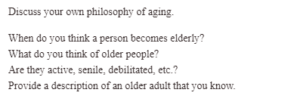Aging Philosophy
Aging refers to structural and functional deterioration in all living organisms over time. Whereas alterations in this functionality state are characteristic of the normal developmental process in living organisms, the hallmark of aging includes physiologic changes at the organ level that lead to a decline in functionality (Ferrucci et al., 2018). The nature of these alterations varies, with each organ system exhibiting different aging profiles. Get in touch with us at eminencepapers.com. We offer assignment help with high professionalism.
Aging begins after passing the peak developmental stage, which usually ranges from ages 18-25. After 25 years of age, these physiologic alterations characteristic of aging start but at a slower rate. However, towards 65 years, the rate accelerates, and evidence of aging is apparent. At 65, the person is considered elderly (Salthouse, 2017). Older people, by a factor of their age and the propensity to exhibit some reduction in functionality, require a few considerations in their handling. Whereas some older adults may still be strong and still at par with their physical functionalization and daily routines, others may be senile, incapacitated, and debilitated by factors attributed to their age (Woods et al., 2016). These abnormalities may be the reason for their incarcerations, but they should not be used to profile them without considering their abilities.
Older adults I know exhibit variations in their abilities and health profile. The health profile of most older adults I know of is varied, with the majority being victims of at least one chronic disease and being on medication for those diseases. The most implicated conditions include coronary heart disease and hypertension. However, a good number shows a better response to treatment, with just a few incarcerated for their disease conditions. Regarding their abilities, the majority can still carry out physical activities, albeit the intensity and frequency are considerably reduced. Their presentation is, however, indicative of the catching age with evidence of wrinkles and reduced physical strength.
References
Ferrucci, L., Levine, M., Kuo, P., & Simonsick, E. (2018). Time and the Metrics of Aging. Circulation Research, 123(7), 740-744. https://doi.org/10.1161/circresaha.118.312816
Salthouse, T. (2017). When does age-related cognitive decline begin? Neurobiology Of Aging, 30(4), 507-514. https://doi.org/10.1016/j.neurobiolaging.2008.09.023
Woods, N., Rillamas-Sun, E., Cochrane, B., La Croix, A., Seeman, T., & Tindle, H. et al. (2016). Aging Well: Observations From the Women’s Health Initiative Study. The Journals Of Gerontology Series A: Biological Sciences And Medical Sciences, 71(Suppl 1), S3-S12. https://doi.org/10.1093/gerona/glv054
ORDER A PLAGIARISM-FREE PAPER HERE
We’ll write everything from scratch
Question

Aging Philosophy
Discuss your own philosophy of aging.
When do you think a person becomes elderly?
What do you think of older people?
Are they active, senile, debilitated, etc.?
Provide a description of an older adult that you know.

